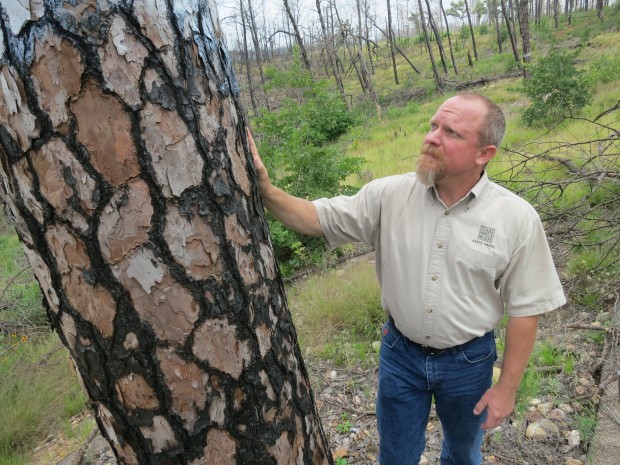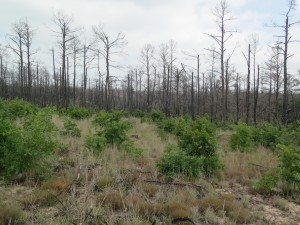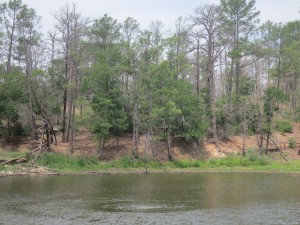As Wildfire Season Burns On, Lessons Abound in Bastrop, Texas

Photo by Mose Buchele
Texas Parks and Wildlife Natural Resources Coodinator Greg Creacy looks at a pine tree burned in the historic wildfires of 2011. Oak trees grow behind him.
Take a trip to the lake at Bastrop State Park, and -at first glance- everything appears normal. The loblolly pine trees that line the shore are singed, but not decimated by the wildfires that struck there in 2011. A turtle suns itself on a rock, a lizard scurries into the underbrush.
Look closer and you see something strange. Large air bubbles are rising from the center of the lake. Erosion caused by those fires is depleting the water of oxygen, so park officials pump air into the water to help all those turtles, fish, and the rest survive.
Welcome to an ecosystem on life support.
In 2011, wildfires burned around 95 percent percent of the Park, which was part of the south westernmost loblolly pine forest in Texas. Now, officials are trying to restore that forest, and their efforts are revealing lessons about the land that could help after fires in other parts of the country.
For one thing, it could show people what to expect.
“Following the wildfire we have this blank slate,” Greg Creacy, a natural resources coordinator with Texas Parks and Wildlife, told StateImpact Texas. “We have all of this bare ground that can be colonized by any plant, and so we’re seeing native plants, unfortunately we’re seeing exotic plants colonize this bare ground as well.”
“They were developed by the agriculture industry to be used as forage. But they have escaped and are now quite a challenge to manage in a wild environment,” Creacy said.
He is talking about hybrid grasses made for cattle. A type called KR Blue stem is a special challenge. Park managers fight it with herbicide and by planting native seeds.
The insects are even harder to control, as I saw first hand when we stumbled across a large mound of fire ants in what had been a dense part of the forest.
“Fire ants are becoming much more common in the park than they were prior to the fire because we lost our [tree] canopy,” Creacy said. “Fire ants prefer sunshine so they’ve become quite common.”
Those ants aren’t just a nuisance, they are deadly to other species like the endangered Houston toad that calls Bastrop home.

Photo by Mose Buchele
Oak trees grow in the foreground, while dead pine trees stand in testament to the fire's destructive power.
In another part of the park the sound of wind blowing through the leaves might be taken as a good sign. But unfortunately, they are not the kind of leaves park manager want to see. Officials say Post Oak, which, unlike pine, can grow out of older root systems, is taking over the forest.
“If we didn’t do anything, the stage is set for this to become a post oak woodland instead of a pine forest,” Creacy said.
That may have been the biggest discovery of all: an understanding of just how fragile this ecosystem was to begin with.
As Creacy talks, one almost gets the sense that restoration efforts have taken on an element of warfare. Loblolly Pine forest used to stretch farther into Central Texas, but have been gradually retreating eastwards. The Lost Pines was the last remnant of what had once been a larger forest. In a sense, Bastrop has become a battle line where park managers are hoping to stop that retreat, at least temporarily.
“We would not get our pine forests back if we didn’t plant them on our own,” Creacy said.
Lessons From the Fire
In the two years since the fire, land managers have learned more about the importance of battling erosion, which can be as damaging to the land as the fire itself. They have also developed an advanced system for mapping fire severity that relied on aerial photography. Both approaches could help in the aftermath of other forests fires in the south and southwest.

Photo by Mose Buchele
Look closely, you can see bubble rising form the lake in an attempt to bring oxygen to the lake.
Creacy says the experience in Bastrop also makes a good case for being proactive about restoration. That could be especially important with more wildfires predicted in the future due to global climate change
The restoration efforts may be slowly paying off.
Back at the lake I ran into Will McCann. He’s thinking about taking up fishing. He was there with his dog Dixie to give it a shot.
“I’m hoping to catch something,” said McCann. “I mean even if it’s small or big. Just something to give me hope for the future.”
His odds of finding that hope increased by the mysterious bubbles rising from the center of the lake.